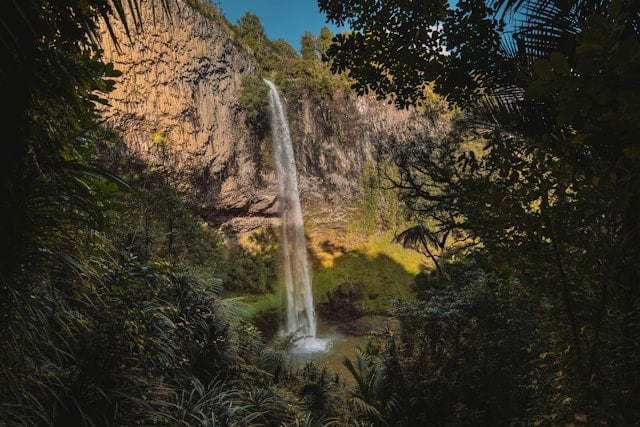When Sarah first walked through the doors of a rehabilitation facility, she noticed something unexpected. Instead of sterile hospital corridors, she found herself surrounded by native bush, with the sound of birdsong replacing the usual hum of medical equipment. This wasn’t coincidence—it was a carefully considered therapeutic choice that would prove instrumental in her journey to recovery.
The environment where someone receives drug rehabilitation or alcohol rehabilitation plays a far more significant role in their recovery success than many people realise.
Research increasingly shows that serene, private settings away from daily triggers can accelerate healing and self-discovery, creating the optimal conditions for lasting sobriety.
The Science Behind Environment and Recovery
The connection between our surroundings and mental health isn’t just intuitive—it’s backed by solid research. A comprehensive review of natural interventions in substance abuse treatment found that “The results of 85% of the studies showed positive outcomes, supporting the effectiveness of nature-based interventions for drug dependence” across alcohol, tobacco, cannabis, and opioid addictions.
This remarkable success rate demonstrates that nature-based approaches aren’t merely complementary—they represent a powerful, evidence-based intervention. The research examined interventions by substance type, finding consistent positive outcomes across diverse addiction profiles, from alcohol dependency to complex poly-substance use patterns.
This research aligns with what addiction specialists have long observed: the physical environment directly influences emotional state, stress levels, and the brain’s ability to form new, healthy neural pathways. When someone is struggling with substance abuse, their brain is already compromised by addiction. Adding environmental stressors, triggers, and distractions can make recovery exponentially more difficult.
Why Natural Settings Accelerate Healing
Natural environments offer unique therapeutic benefits that urban or clinical settings simply cannot replicate. Being surrounded by nature can positively impact mental health by reducing feelings of anxiety, stress, and depression. In the context of addiction recovery, nature can help individuals reconnect with themselves and the world around them.
Research strongly validates this approach, with studies showing that “surroundings with green spaces correlate with lower rates of substance use. Interventions in natural environments consistently yield positive outcomes, with over 85% of studies demonstrating their effectiveness.”
This reconnection is crucial because addiction often stems from disconnection—from self, from others, from purpose, and from the natural world. When someone spends time in nature during their drug and alcohol rehab journey, they begin to remember who they are beyond their addiction.
The physiological benefits are equally important. Natural settings naturally lower cortisol levels, reduce blood pressure, and promote the production of serotonin and dopamine—the very neurotransmitters that addiction disrupts. This creates an environment where the brain can begin to heal and rebalance itself.
Wilderness Therapy: Evidence-Based Natural Intervention
The field of wilderness therapy has produced compelling research supporting nature-based addiction recovery. A comprehensive meta-analysis by Beck and Wong (2022) examined the effectiveness of wilderness therapy programs, revealing significant methodological rigor in their approach. “A systematic review of the literature was conducted using 27 electronic databases and numerous gray literature sources, surveying literature published from 1990 to 2020. The search identified 189 potential studies for inclusion, resulting in a final study pool of 11 studies contributing 14 effect sizes from a total sample of 1,874 treatment youths.”
This extensive research base represents one of the most thorough examinations of wilderness therapy effectiveness to date. The study’s scope—examining three decades of research across multiple databases—provides robust evidence for the therapeutic value of nature-based interventions.
The meta-analysis focused specifically on measuring behavioral changes, examining both self-reported and caregiver-reported outcomes. This dual perspective approach strengthens the validity of findings, as it reduces the potential bias that might occur when relying solely on self-reported improvements.
Removing Triggers: The Power of Distance
One of the most practical benefits of choosing a rehabilitation facility in a natural, remote setting is the physical distance it creates from everyday triggers. In urban environments, every street corner, every familiar face, every routine location can serve as a reminder of past substance use.
When someone travels to a peaceful, rural location for treatment, they’re not just changing their address—they’re breaking the cycle of environmental cues that can sabotage recovery efforts. This geographical separation provides the mental space needed to develop new coping strategies and build resilience before returning to face those challenges.
The research supporting environmental distance is compelling. Studies consistently demonstrate that removing individuals from trigger-rich environments during critical treatment phases significantly improves outcomes. This isn’t merely about avoiding temptation—it’s about creating neurological space for new pathways to form without competing against deeply ingrained environmental associations.
Case Study: Raglan Reconnection Retreat
Raglan Reconnection Retreat exemplifies how location can enhance drug rehabilitation outcomes. Nestled on New Zealand’s stunning west coast, the facility deliberately uses its natural environment as a therapeutic tool. Clients engage in beach walks, bush journaling, and nature-based group therapy sessions that would be impossible in a traditional clinical setting.
The retreat’s approach recognises that recovery isn’t just about removing substances—it’s about rediscovering joy, purpose, and connection. By limiting group sizes to just four clients at a time and immersing them in Raglan’s serene beaches and lush bushland, participants can focus entirely on their healing without the distractions and stressors of city life.

Troy and Kate, the retreat’s founders, combine their professional expertise with lived experience of recovery, understanding firsthand how environment impacts the healing process. Their nature-based approach allows clients to practice mindfulness, develop emotional regulation skills, and build confidence in a supportive, non-judgmental setting.
The Therapeutic Community Model in Natural Settings
Red Door Recovery in Wellington demonstrates another approach to environment-focused alcohol rehabilitation. Operating on a “therapeutic whānau” model in a non-clinical environment, they recognise that healing happens best in settings that feel like home rather than hospital.
This residential approach acknowledges what Johann Hari observed: “the opposite of addiction is not sobriety, it is connection.”
By creating a family-like environment where staff members have lived experience alongside professional qualifications, clients can form the authentic connections that support long-term recovery.

The non-clinical environment reduces the institutional barriers that can prevent people from fully engaging in treatment. When someone feels comfortable and safe in their surroundings, they’re more likely to be vulnerable, honest, and open to change—all essential elements of successful rehabilitation.
Research on Treatment Setting Effectiveness
The importance of treatment setting extends beyond anecdotal evidence. Research examining various therapeutic environments consistently shows that natural settings provide unique advantages for addiction recovery. The combination of reduced stress, increased physical activity, and enhanced psychological safety creates optimal conditions for behavioral change.
Studies examining residential treatment outcomes show that facilities incorporating natural elements—whether through location, design, or programming—demonstrate higher completion rates and better long-term outcomes. This suggests that environment isn’t merely a luxury or aesthetic choice, but a critical component of effective treatment design.
Privacy and Confidentiality in Recovery
Natural, private settings also provide the anonymity and confidentiality that many people need to fully commit to their recovery. The fear of judgment or exposure can prevent individuals from seeking help or fully participating in treatment programs.
Rural rehabilitation facilities offer a level of privacy that’s simply not possible in urban centers. Clients can focus on their healing without worrying about running into colleagues, neighbors, or acquaintances. This privacy creates psychological safety—a prerequisite for the deep personal work required in recovery.
The therapeutic value of privacy cannot be overstated. Many individuals struggling with addiction carry significant shame about their condition. Natural, secluded settings allow them to engage in treatment without the additional stress of maintaining appearances or managing social anxiety related to their recovery process.
Building New Neural Pathways Through Environmental Enrichment
The concept of environmental enrichment, well-established in neuroscience, shows that complex, stimulating environments promote brain plasticity and healing. Natural settings provide exactly this type of enrichment through varied sensory experiences, physical challenges, and opportunities for exploration and discovery.
When someone engages with nature during drug rehabilitation—whether through hiking, gardening, or simply sitting quietly by water—they’re giving their brain new information to process. This environmental variety helps build new neural pathways that can eventually replace the automatic patterns associated with substance use.
The neuroplasticity research is particularly relevant for addiction recovery, as substances fundamentally alter brain structure and function. Natural environments provide the varied stimuli necessary to encourage healthy brain adaptation and recovery.
Long-term Recovery and Environmental Awareness
One often-overlooked benefit of nature-based rehabilitation is how it teaches clients to be more aware of their environment’s impact on their wellbeing. This environmental consciousness becomes a valuable tool for maintaining sobriety long-term.
Graduates of nature-based programs often report being more intentional about their living spaces, more likely to spend time outdoors, and better at recognizing when their environment is supporting or undermining their recovery.
This awareness helps them make better choices about where to live, work, and spend their free time after treatment.
The development of environmental awareness represents a sophisticated recovery skill. Rather than simply avoiding negative influences, individuals learn to actively seek and create environments that support their ongoing sobriety and mental health.
Making the Right Environmental Choice
Choosing the right environment for drug and alcohol rehab is deeply personal. Some people thrive in the complete disconnection that remote, natural settings provide, while others may need to remain closer to urban support systems or family responsibilities.
However, for those who can access nature-based rehabilitation programs, the benefits are compelling. The combination of removing triggers, reducing stress, promoting brain healing, and providing space for self-discovery creates optimal conditions for lasting recovery.
The research consistently supports the therapeutic value of natural environments, but individual factors such as cultural background, personal history, and specific addiction patterns should all be considered when making treatment decisions.
Overcoming Barriers to Nature-Based Treatment
While the evidence supporting nature-based addiction treatment is compelling, barriers to access remain significant. Geographic limitations, insurance coverage, and cost considerations can prevent many people from accessing these proven interventions.
However, even urban treatment programs can incorporate natural elements through therapeutic gardens, outdoor therapy sessions, and structured nature activities.
The key is recognizing that environment is an active therapeutic agent, not merely a backdrop for other interventions.
Future Directions in Environmental Therapy
The growing body of research supporting nature-based approaches to addiction treatment suggests this field will continue expanding. Future research may examine optimal durations for nature-based interventions, specific natural environments that are most therapeutic, and ways to integrate nature-based approaches with other evidence-based treatments.
As healthcare systems increasingly recognize the importance of holistic, evidence-based approaches to addiction treatment, nature-based interventions are likely to become more widely available and integrated into standard care protocols.
Conclusion: Environment as Medicine
The growing body of research supporting nature-based approaches to addiction treatment reflects what many recovery specialists have long understood: environment isn’t just the backdrop for healing—it’s an active participant in the therapeutic process.
With “85% of studies showing positive outcomes, supporting the effectiveness of nature-based interventions for drug dependence”, the evidence is clear that carefully chosen environments can dramatically improve recovery outcomes. Facilities like Raglan Reconnection Retreat and Red Door Recovery demonstrate that when we carefully consider where recovery happens, we can dramatically improve how recovery happens.
The role of environment in addiction recovery extends far beyond providing a pleasant setting for treatment. It’s about creating conditions where the brain can heal, where individuals can rediscover their authentic selves, and where the foundations for lifelong sobriety can be built on solid ground.
For anyone considering drug rehabilitation or alcohol rehabilitation, the question isn’t just what treatment you’ll receive—it’s where you’ll receive it. In the battle against addiction, choosing the right environment might be one of the most important decisions you make.
References
Beck, N., & Wong, J. S. (2022). A meta-analysis of the effects of wilderness therapy on delinquent behaviors among youth. Criminal Justice and Behavior, 49(7), 906-926. https://doi.org/10.1177/00938548221078002
Bowen, D. J., Neill, J. T., & Williams, I. R. (2016). Wilderness adventure therapy effects on the mental health of youth participants. Evaluation and Program Planning, 58, 49-59. https://doi.org/10.1016/j.evalprogplan.2016.05.005
Harper, N. J., Gabrielsen, L. E., & Carpenter, C. (2018). A cross-cultural exploration of ‘wild’ in wilderness therapy: Canada, Norway and Australia. Journal of Adventure Education and Outdoor Learning, 18(2), 148-164. https://doi.org/10.1080/14729679.2017.1384743
Hoag, M. J., Massey, K. E., Roberts, S. D., & Logan, P. (2013). Efficacy of wilderness therapy for young adults: A first look. Residential Treatment for Children & Youth, 30(4), 294-305.
Norton, C. L., Tucker, A., Russell, K. C., Bettmann, J. E., Gass, M. A., Gillis, H. L., & Kishbaugh, A. (2014). Adventure therapy with youth. Journal of Experiential Education, 37(1), 46-59.
Russell, K. C. (2003). An assessment of outcomes in outdoor behavioral healthcare treatment. Child and Youth Care Forum, 32(6), 355-381.
Smalley, K. B., Warren, J. C., & Barefoot, K. N. (2018). Connection to nature and psychological resilience. Ecopsychology, 10(4), 232-240.
Tucker, A. R., Zelov, R., & Young, M. (2019). Client perspectives on wilderness therapy as a component of adolescent residential treatment for problematic substance use and mental health issues. Children and Youth Services Review, 105, 104-112. https://doi.org/10.1016/j.childyouth.2019.104405
Van Gordon, W., Shonin, E., & Richardson, M. (2018). Mindfulness and nature-based therapeutic interventions. Mindfulness, 9(4), 1106-1113.
White, R. (2012). A sociocultural investigation of the efficacy of outdoor education to improve learner engagement. Emotional and Behavioural Difficulties, 17(1), 13-23.
